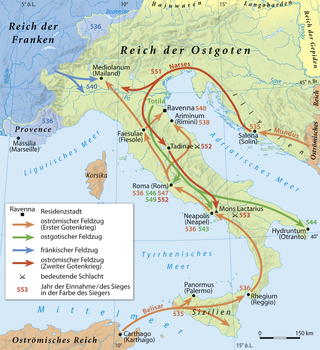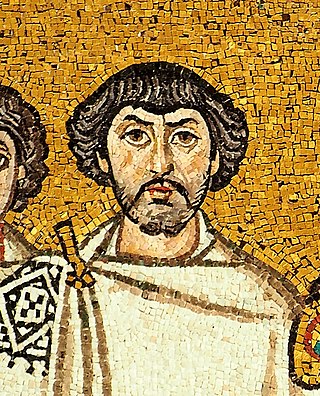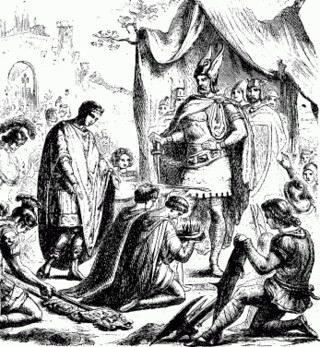Related Research Articles

The Ostrogoths were a Roman-era Germanic people. In the 5th century, they followed the Visigoths in creating one of the two great Gothic kingdoms within the Roman Empire, based upon the large Gothic populations who had settled in the Balkans in the 4th century, having crossed the Lower Danube. While the Visigoths had formed under the leadership of Alaric I, the new Ostrogothic political entity which came to rule Italy was formed in the Balkans under the influence of the Amal dynasty, the family of Theodoric the Great.
The 540s decade ran from January 1, 540, to December 31, 549.
The 450s decade ran from January 1, 450, to December 31, 459.
Foederati were peoples and cities bound by a treaty, known as foedus, with Rome. During the Roman Republic, the term identified the socii, but during the Roman Empire, it was used to describe foreign states, client kingdoms or barbarian tribes to which the empire provided benefits in exchange for military assistance. The term was also used, especially under the empire, for groups of "barbarian" mercenaries of various sizes who were typically allowed to settle within the empire.
Ildibad was a king of the Ostrogoths in Italy in 540–541.

The Gothic War between the Eastern Roman Empire during the reign of Emperor Justinian I and the Ostrogothic Kingdom of Italy took place from 535 to 554 in the Italian Peninsula, Dalmatia, Sardinia, Sicily and Corsica. It was one of the last of the many Gothic Wars against the Roman Empire. The war had its roots in the ambition of the Eastern Roman (Byzantine) Emperor Justinian I to recover the provinces of the former Western Roman Empire, which the Romans had lost to invading barbarian tribes in the previous century, during the Migration Period.

Belisarius was a military commander of the Byzantine Empire under the emperor Justinian I. He was instrumental in the reconquest of much of the Mediterranean territory belonging to the former Western Roman Empire, which had been lost less than a century prior.
Artabazes, whose name is often latinised as Ardabastos, was a Sasanian cavalryman and later a Byzantine military officer, recorded taking part in the Roman-Persian Wars and Gothic War. He was killed just prior to the Battle of Faventia. The main source about him is Procopius.

Odoacer's deposition of Romulus Augustus, occurring in 476 AD, was a coup that marked the end of the reign of the Western Roman Emperor last approved by the Western Roman Senate and the creation of the Kingdom of Italy, although Julius Nepos exercised control over Dalmatia until 480. Romulus Augustus was a 16-year-old minor at the time.

The city of Rome was besieged in AD 549–550 by the Ostrogoths, led by Totila, during a campaign to recapture Italy from the Byzantine Empire. After Totila imposed a blockade, soldiers from the city's garrison opened the gates to him. Many of the male inhabitants were killed in the city or while attempting to flee. The city was afterwards repopulated and rebuilt.
The siege of Verona in the winter of 541, was an engagement during the Gothic War (535–554).
The Battle of Mucellium was an engagement in 542 near Mugello, Italy, between Ostrogoths and Byzantines during the Gothic War. Having lifted a siege of Florence, the Ostrogoths led by Totila turned on the pursuing Byzantines, defeating their numerically superior force.
Bessas was an East Roman (Byzantine) general of Gothic origin from Thrace, primarily known for his career in the wars of Justinian I. He distinguished himself against the Sassanid Persians in the Iberian War and under the command of Belisarius in the Gothic War, but after Belisarius' departure from Italy he failed to confront the resurgent Goths and was largely responsible for the loss of Rome in 546. Returning east in disgrace, despite his advanced age he was appointed as commander in the Lazic War. There he redeemed himself with the recapture of Petra, but his subsequent idleness led Justinian to dismiss him and exile him to Abasgia.
The siege of Panormus was a Byzantine siege of the Ostrogothic fortified city of Panormus in late 535, during the Gothic War (535–554). A Byzantine army of 7,500–9,000 and a fleet, both under the command of general Belisarius, laid siege to the city, which refused to surrender unlike all the other Ostrogothic-held cities in Sicily. Belisarius ordered his fleet to sail into the harbor and anchor beside the wall. Small boats filled with archers were hoisted on top of the ships' masts, which surpassed the height of the parapet. The fire from the archers convinced the Ostrogoths to surrender, completing the conquest of Sicily.
The siege of Auximus was a siege during Justinian’s Gothic War which took place in the year 539. It ended with the Belisarius’ Byzantine force victorious. The Gothic garrison surrendered the town and joined the Byzantines after negotiations. The siege lasted 7 months.
The siege of Ravenna of 539-540 took place during Justinian’s Gothic War. After clearing out Ariminum, Urviventus, Urbinus and Auximus the road to Ravenna was open to the Byzantines. In late 539 or early 540 Belisarius, victor of engagements like Dara, Ad Decimum and Rome, marched on Ravenna while Vitalius was already in the area. Vitalius discovered a grain shipment destined for Ravenna and captured it. When news of the siege spread many Gothic garrisons began to surrender. The city itself was taken when Belisarius was offered the Ostrogothic throne and faked acceptance.
Simmas was a Hunnic general in the service of the Byzantine Empire, serving as dux. Active in the early 6th century, he fought at the Battle of Dara, commanding six hundred horseman along with fellow Hun commander Ascan, and played a fundamental role in the Byzantine victory.
Zolban or Zolbon was a Hun general fighting for the Byzantine Empire. He fought alongside fellow Hun commander Sigizan against the Isaurians in 493 AD.
Althias was a Hun military commander in the Byzantine Empire. He is noted for defeating Iaudas, king of the Moors, and his army with just 70 men.
Apsich or Aspik was a Hun military leader in the Byzantine Empire.
References
- 1 2 Maenchen-Helfen, Otto J. "The World of the Huns. Chapter IX. Language". www.kroraina.com. Retrieved 27 October 2022.
- ↑ Rubin, Berthold; Capizzi, Carmelo (1960). Das Zeitalter Iustinians Volume 2 (in German). W. de Gruyter. p. 178. Retrieved 27 October 2022.
- 1 2 Prokopios; Kaldellis, Anthony (2014). Dewing, H. B. (ed.). The Wars of Justinian. Hackett Publishing Company, Incorporated. p. 426. ISBN 9781624661723 . Retrieved 27 October 2022.